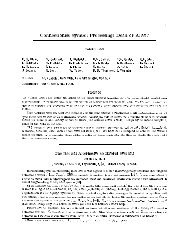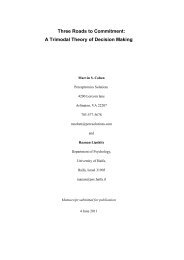Three Roads to Commitment: A Trimodal Theory of Decision Making
Three Roads to Commitment: A Trimodal Theory of Decision Making
Three Roads to Commitment: A Trimodal Theory of Decision Making
You also want an ePaper? Increase the reach of your titles
YUMPU automatically turns print PDFs into web optimized ePapers that Google loves.
<strong>Three</strong> <strong>Roads</strong> <strong>to</strong> <strong>Commitment</strong>: A <strong>Trimodal</strong> <strong>Theory</strong> <strong>of</strong> <strong>Decision</strong> <strong>Making</strong> 33<br />
cognitive effort or processing time required by an agent <strong>to</strong> answer the primary question associated with a decision<br />
mode. This concept is ecological, because it spans features <strong>of</strong> both the decision maker and the environment. 15<br />
Different cognitive strategies are made objectively possible (i.e., afforded) by informational features <strong>of</strong> the<br />
environment in conjunction with the decision maker’s relevant cultural, organizational, and personal knowledge and<br />
capacities for perception, recollection, reasoning, and interacting with others. Action uncertainty is not an<br />
instantaneous time slice <strong>of</strong> the agent’s mental contents, or any other instantaneous measure regarding the decision<br />
maker (e.g., momentary betting odds) or <strong>of</strong> the environment (e.g., availability <strong>of</strong> the head nurse). First, information<br />
that reduces action uncertainty may be in the decision maker’s head (e.g., scenario ii), but it need not be (e.g.,<br />
scenario i). It may be accessed just as readily when s<strong>to</strong>red in the environment – e.g., standard procedures for<br />
handling an emergency may be looked up and then utilized in procedural management (Orasanu & Fischer, 1997).<br />
Second, action uncertainty is not subjective in the sense <strong>of</strong> being up <strong>to</strong> the decision maker. It is an objective feature<br />
<strong>of</strong> the decision problem. (It is relative <strong>to</strong> a decision maker, however, because it can vary for persons with different<br />
skills and knowledge facing the same problem.) Third, action uncertainty at a particular moment is a function <strong>of</strong><br />
what occurs beyond that moment; it refers <strong>to</strong> future decision making cycles that must occur during the interval –<br />
however long or short – before commitment is final and action occurs. Ideally it declines as information is acquired<br />
or generated, over fractions <strong>of</strong> a second or months – until it reaches a vanishing point after complete<br />
implementation. Thus, TDM’s concept <strong>of</strong> action uncertainty satisfies part <strong>of</strong> the pragmatic condition: it is defined so<br />
that it corresponds <strong>to</strong> difficulty. The requirement for an unanswered primary question completes the pragmatic<br />
condition, by ensuring that difficulty pertains <strong>to</strong> decision making rather than idle curiosity. The fact that primary<br />
questions frame the effort within a decision mode extends the concept beyond choice, and thus ensures generality.<br />
The differentiation condition for action uncertainty is addressed by two further elements: secondary questions<br />
and uncertainty types defined in terms <strong>of</strong> their status. If the decision maker has some familiarity with the decision<br />
setting, the primary questions interact with the current frame and with the environment <strong>to</strong> generate secondary<br />
questions, which direct attention <strong>to</strong> specific parts <strong>of</strong> the decision problem (features <strong>of</strong> the situation and decision<br />
maker role in matching, features <strong>of</strong> options and the desirability <strong>of</strong> their consequences in choice, and relevant<br />
15 We use affordance in what we take <strong>to</strong> be analogous <strong>to</strong> Gibson’s (1979) original sense: “physical possibilities for<br />
action” (e.g., stair climbing) construed as a specific objective relationship between features <strong>of</strong> the environment (e.g.,<br />
the height <strong>of</strong> a step) and an agent’s physical capacity (e.g., his stride length) (Chemero, 200). TDM extends the idea<br />
<strong>to</strong> include strategies for making and modifying commitment.




